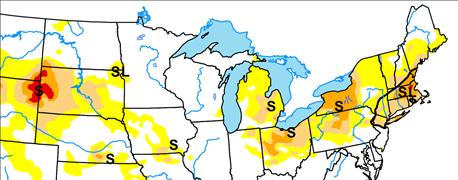
If you’re under siege by dry weather and missed rains, there’s little solace in knowing you have lots of company in the same boat — with little or no water to paddle in. Northeast producers who purchased crop insurance will at least feel a little more solace. For winegrape growers, however, it was near-perfect weather.

COOKED BEFORE ITS TIME: Corn grain and silage yields were cooked down by heat and lack of sufficient rainfall in much of the Northeast.
In early August, crop insurance adjusters in central and western New York reported 70% to 80% corn grain losses on many farms and 50% to 60% corn silage losses. Since soybeans have some “staying power,” adjusters typically don’t assess bean losses until pod set is complete. But it’s clear that Northeast crop yields won’t be adding to any record-setting U.S. crop.
Early August’s drought map from the National Drought Mitigation Center (see map) showed worsening drought conditions across much of the Northeast, from southwestern Pennsylvania up into New England. Forecasts for the rest of August in these areas were much the same — warm and drier-than-normal weather.
A closer look
In general, crop losses were already confirmed by mid-August’s USDA Crop Progress Report, with some exceptions in areas closest to the coast. Here’s a closer look at the National Agricultural Statistics Service’s reports for the Northeast:
Delaware/Maryland. Corn and soybeans on the Delmarva generally ranged from fair to excellent condition due to heavy irrigation use — despite reaching triple-digit temperatures several times. Central Maryland corn and soybeans, according to the report, looked “very good to excellent” in most locations, with other areas “not up to that measure” due to being missed by rains.
Maryland top soil moisture levels averaged 28% short to very short. Delaware top soil moisture levels were rated 49% short to very short. But that’s not unusual, and why many of these farms rely on irrigation.
New England. Drought conditions continued throughout much of the region. Even Connecticut experienced days with 100-plus-degrees F. Rainfall was generally hit or miss, with more misses than hits, and a few torrential downpours.
Sporadic showers provided only limited relief. Much of Massachusetts, southernmost parts of New Hampshire, and northern Connecticut and Rhode Island remained under severe drought conditions.
Most of the region suffered rain deficits of 3 to more than 7 inches since April 1. Top soil moisture levels for the region averaged 66% short to very short.
New Jersey. Rainfall levels during the week varied by locale, from 2 inches in the north to none. Rainfall deficits since April 1 generally ranged from 1.5 to 4 inches. Top soil moisture was rated 32% short to very short.
New York. Many areas experienced scattered thunderstorms and damaging winds along with much needed rainfall during early August. Even so, numerous areas reported still being in a drought. In most cases, the rains were too late and too little to prevent crop damage.
Most of the Empire State averaged rainfall accumulations since April 1 of 3 to 6 inches less than normal. Statewide, top soil moisture for the week averaged 49% short to very short. Cooperstown, N.Y., however, was a strange anomaly, reporting more than 9 inches above normal.
Pennsylvania. Despite some improvement due to recent rains, the majority of farm operators have contacted local crop insurers to set up crop damage assessments. Crop condition and yields are still expected to be subpar. Top soil moisture across the Keystone State was rated 45% short to very short. Rainfall accumulations since April 1 generally ranged 2 to 4 inches below normal.
In central, south-central and southwestern counties, drought forced some farms to harvest corn early as forage, according to the reporters. Some have already planted cover crops for emergency forage later this year. But in the southeastern counties of Lebanon and Lancaster, corn and soybeans look good, despite showing signs of moisture stress.
6 ways to minimize high-nitrate feed risks
Corn and forages that have been shut down by drought can accumulate high nitrates, posing potential toxic effects on cattle. Here are six tips on minimizing that risk from Warren Rusche, Extension beef specialist at South Dakota State University:
Highest nitrate concentrations are in the lower parts of the plant, so cutting higher than normal helps reduce the amount in harvested silage.
Pregnant cattle are much more sensitive to high nitrates. If possible, save low-nitrate feeds for cattle in late gestation. Direct high-nitrate feeds to growing or finishing cattle.
When diluting high-nitrate feeds, make sure the forages are mixed evenly to minimize the chance of individual animals ingesting too much nitrate. Self-feeding high-nitrate hay is dangerous for the same reason.
Increasing feeding frequency and including grain in the ration help reduce the toxic effects.
Give cattle the opportunity to adapt to high-nitrate feedstuffs by gradually increasing the amount in their diets.
Consider ensiling the feedstuffs when possible. The fermentation process can reduce nitrate concentrations by about 33%. Because this response can vary, it is a good idea to test ensiled forages at least four weeks after harvest to determine the final nitrate levels.
About the Author(s)
You May Also Like




